brakes KIA Sorento 2016 3.G Owner's Guide
[x] Cancel search | Manufacturer: KIA, Model Year: 2016, Model line: Sorento, Model: KIA Sorento 2016 3.GPages: 565, PDF Size: 10.63 MB
Page 426 of 565
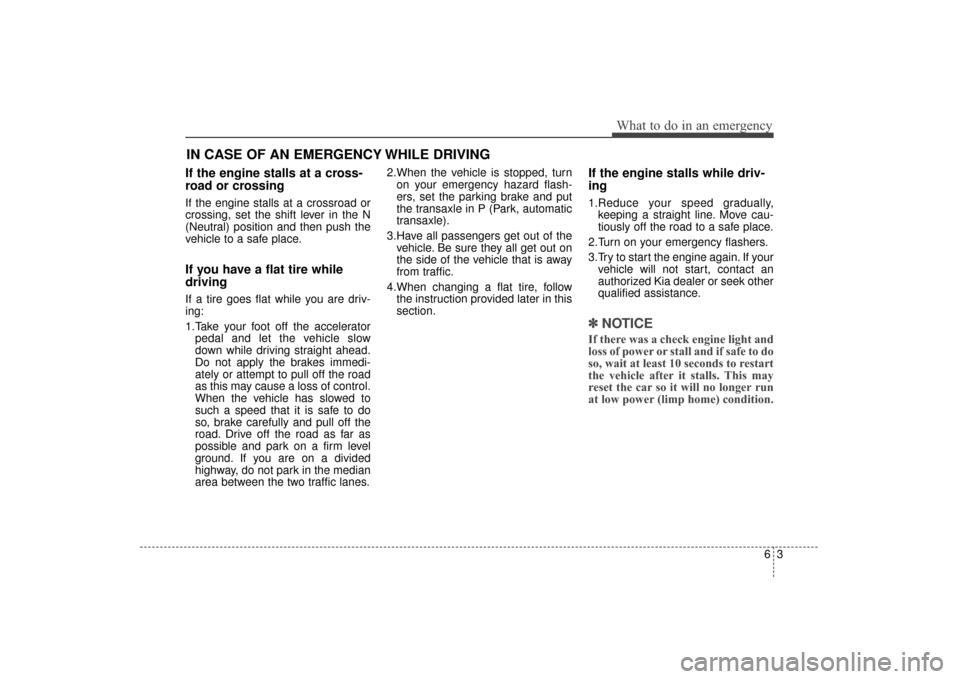
63
What to do in an emergency
If the engine stalls at a cross-
road or crossing
If the engine stalls at a crossroad or
crossing, set the shift lever in the N
(Neutral) position and then push the
vehicle to a safe place.
If you have a flat tire while
driving
If a tire goes flat while you are driv-
ing:
1.Take your foot off the acceleratorpedal and let the vehicle slow
down while driving straight ahead.
Do not apply the brakes immedi-
ately or attempt to pull off the road
as this may cause a loss of control.
When the vehicle has slowed to
such a speed that it is safe to do
so, brake carefully and pull off the
road. Drive off the road as far as
possible and park on a firm level
ground. If you are on a divided
highway, do not park in the median
area between the two traffic lanes. 2.When the vehicle is stopped, turn
on your emergency hazard flash-
ers, set the parking brake and put
the transaxle in P (Park, automatic
transaxle).
3.Have all passengers get out of the vehicle. Be sure they all get out on
the side of the vehicle that is away
from traffic.
4.When changing a flat tire, follow the instruction provided later in this
section.
If the engine stalls while driv-
ing
1.Reduce your speed gradually,keeping a straight line. Move cau-
tiously off the road to a safe place.
2.Turn on your emergency flashers.
3.Try to start the engine again. If your vehicle will not start, contact an
authorized Kia dealer or seek other
qualified assistance.
✽ ✽ NOTICE
If there was a check engine light and
loss of power or stall and if safe to do
so, wait at least 10 seconds to restart
the vehicle after it stalls. This may
reset the car so it will no longer run
at low power (limp home) condition.
IN CASE OF AN EMERGENCY WHILE DRIVING
UM CAN (ENG) 6.QXP 12/1/2014 1:08 PM Page 3
Page 443 of 565
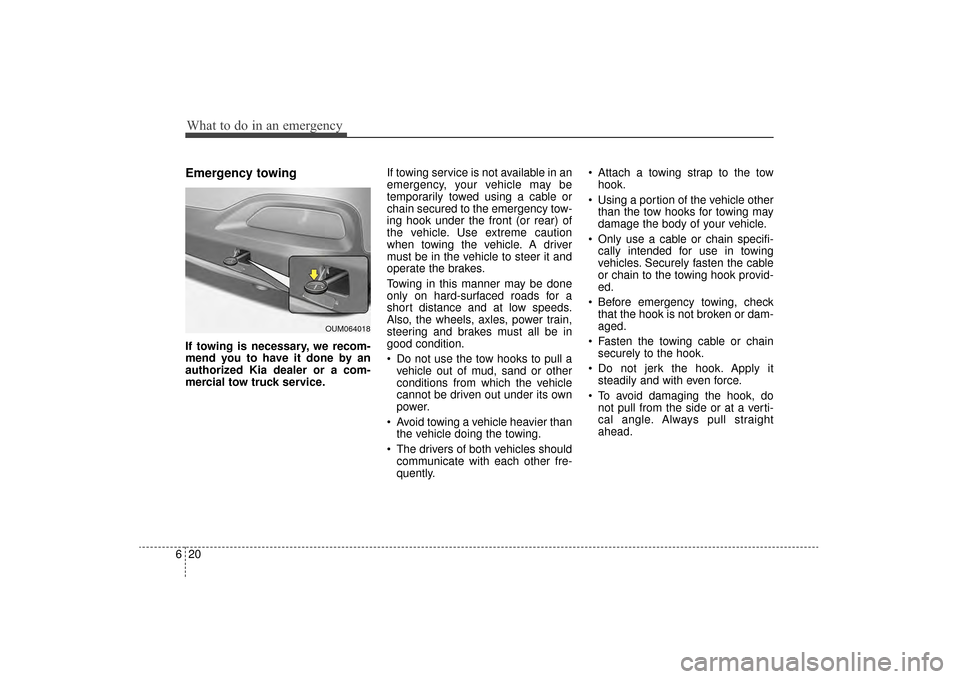
What to do in an emergency
20
6
Emergency towing
If towing is necessary, we recom-
mend you to have it done by an
authorized Kia dealer or a com-
mercial tow truck service. If towing service is not available in an
emergency, your vehicle may be
temporarily towed using a cable or
chain secured to the emergency tow-
ing hook under the front (or rear) of
the vehicle. Use extreme caution
when towing the vehicle. A driver
must be in the vehicle to steer it and
operate the brakes.
Towing in this manner may be done
only on hard-surfaced roads for a
short distance and at low speeds.
Also, the wheels, axles, power train,
steering and brakes must all be in
good condition.
Do not use the tow hooks to pull a
vehicle out of mud, sand or other
conditions from which the vehicle
cannot be driven out under its own
power.
Avoid towing a vehicle heavier than the vehicle doing the towing.
The drivers of both vehicles should communicate with each other fre-
quently. Attach a towing strap to the tow
hook.
Using a portion of the vehicle other than the tow hooks for towing may
damage the body of your vehicle.
Only use a cable or chain specifi- cally intended for use in towing
vehicles. Securely fasten the cable
or chain to the towing hook provid-
ed.
Before emergency towing, check that the hook is not broken or dam-
aged.
Fasten the towing cable or chain securely to the hook.
Do not jerk the hook. Apply it steadily and with even force.
To avoid damaging the hook, do not pull from the side or at a verti-
cal angle. Always pull straight
ahead.
OUM064018
UM CAN (ENG) 6.QXP 12/1/2014 1:09 PM Page 20
Page 444 of 565
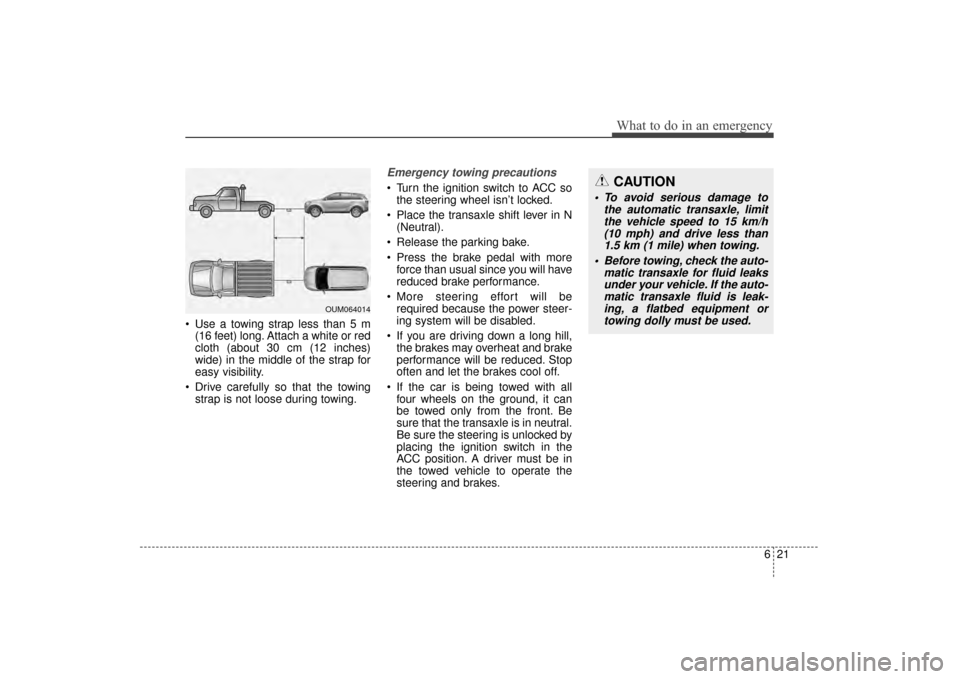
621
What to do in an emergency
Use a towing strap less than 5 m(16 feet) long. Attach a white or red
cloth (about 30 cm (12 inches)
wide) in the middle of the strap for
easy visibility.
Drive carefully so that the towing strap is not loose during towing.
Emergency towing precautions
Turn the ignition switch to ACC sothe steering wheel isn’t locked.
Place the transaxle shift lever in N (Neutral).
Release the parking bake.
Press the brake pedal with more force than usual since you will have
reduced brake performance.
More steering effort will be required because the power steer-
ing system will be disabled.
If you are driving down a long hill, the brakes may overheat and brake
performance will be reduced. Stop
often and let the brakes cool off.
If the car is being towed with all four wheels on the ground, it can
be towed only from the front. Be
sure that the transaxle is in neutral.
Be sure the steering is unlocked by
placing the ignition switch in the
ACC position. A driver must be in
the towed vehicle to operate the
steering and brakes.
OUM064014
CAUTION
To avoid serious damage to the automatic transaxle, limitthe vehicle speed to 15 km/h(10 mph) and drive less than1.5 km (1 mile) when towing.
Before towing, check the auto- matic transaxle for fluid leaksunder your vehicle. If the auto-matic transaxle fluid is leak-ing, a flatbed equipment ortowing dolly must be used.
UM CAN (ENG) 6.QXP 12/1/2014 1:09 PM Page 21
Page 454 of 565
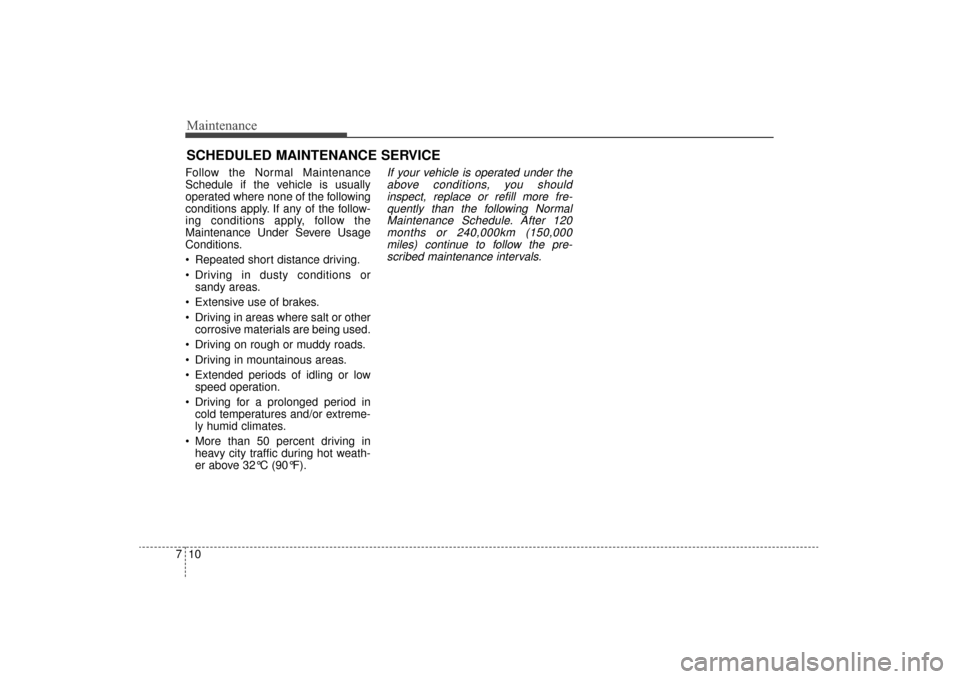
Maintenance
10
7
SCHEDULED MAINTENANCE SERVICE
Follow the Normal Maintenance
Schedule if the vehicle is usually
operated where none of the following
conditions apply. If any of the follow-
ing conditions apply, follow the
Maintenance Under Severe Usage
Conditions.
Repeated short distance driving.
Driving in dusty conditions or
sandy areas.
Extensive use of brakes.
Driving in areas where salt or other corrosive materials are being used.
Driving on rough or muddy roads.
Driving in mountainous areas.
Extended periods of idling or low speed operation.
Driving for a prolonged period in cold temperatures and/or extreme-
ly humid climates.
More than 50 percent driving in heavy city traffic during hot weath-
er above 32°C (90°F).If your vehicle is operated under theabove conditions, you shouldinspect, replace or refill more fre-quently than the following NormalMaintenance Schedule. After 120months or 240,000km (150,000miles) continue to follow the pre-scribed maintenance intervals.
UM CAN (ENG) 7.qxp 12/1/2014 1:17 PM Page 10
Page 482 of 565
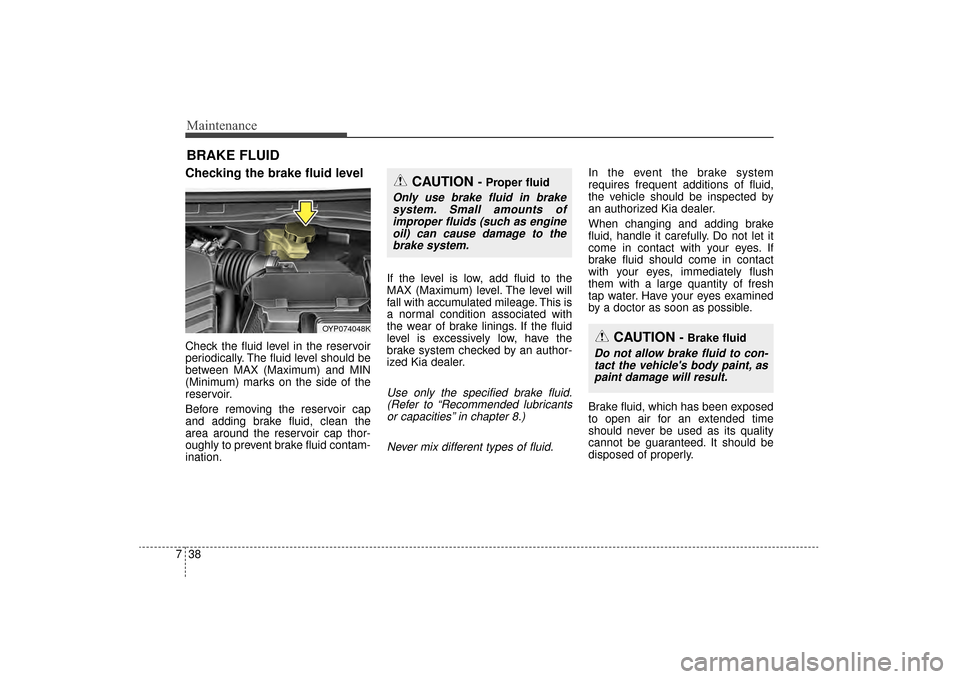
Maintenance
38
7
BRAKE FLUID
Checking the brake fluid level
Check the fluid level in the reservoir
periodically. The fluid level should be
between MAX (Maximum) and MIN
(Minimum) marks on the side of the
reservoir.
Before removing the reservoir cap
and adding brake fluid, clean the
area around the reservoir cap thor-
oughly to prevent brake fluid contam-
ination. If the level is low, add fluid to the
MAX (Maximum) level. The level will
fall with accumulated mileage. This is
a normal condition associated with
the wear of brake linings. If the fluid
level is excessively low, have the
brake system checked by an author-
ized Kia dealer.
Use only the specified brake fluid.
(Refer to “Recommended lubricantsor capacities” in chapter 8.)
Never mix different types of fluid.
In the event the brake system
requires frequent additions of fluid,
the vehicle should be inspected by
an authorized Kia dealer.
When changing and adding brake
fluid, handle it carefully. Do not let it
come in contact with your eyes. If
brake fluid should come in contact
with your eyes, immediately flush
them with a large quantity of fresh
tap water. Have your eyes examined
by a doctor as soon as possible.
Brake fluid, which has been exposed
to open air for an extended time
should never be used as its quality
cannot be guaranteed. It should be
disposed of properly.
OYP074048K
CAUTION - Proper fluid
Only use brake fluid in brakesystem. Small amounts ofimproper fluids (such as engineoil) can cause damage to thebrake system.
CAUTION - Brake fluid
Do not allow brake fluid to con-tact the vehicle's body paint, aspaint damage will result.
UM CAN (ENG) 7.qxp 12/1/2014 1:17 PM Page 38
Page 535 of 565
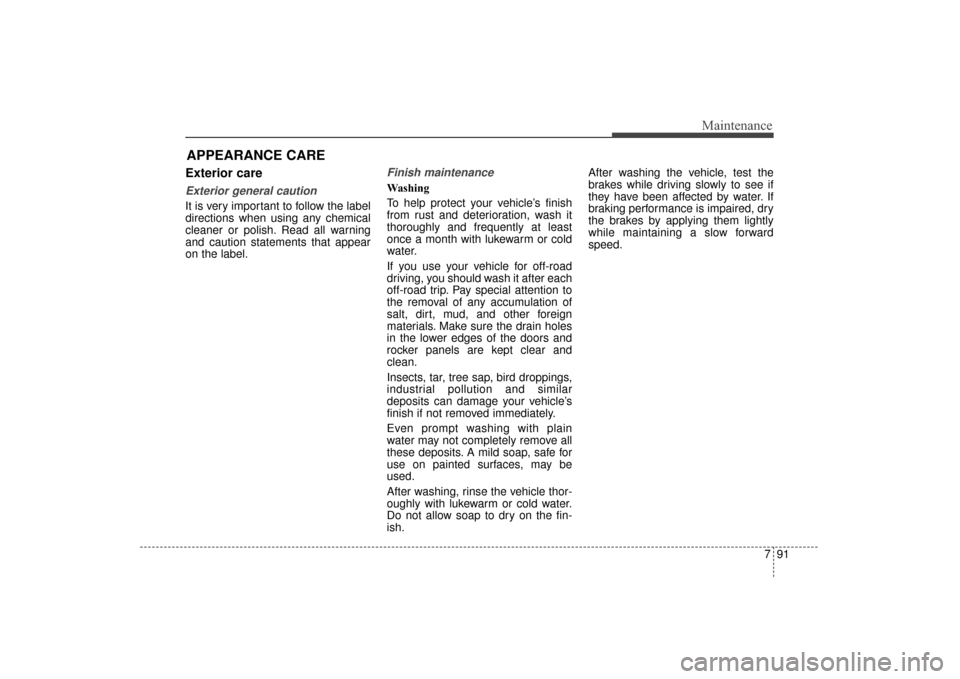
791
Maintenance
APPEARANCE CARE
Exterior care
Exterior general caution
It is very important to follow the label
directions when using any chemical
cleaner or polish. Read all warning
and caution statements that appear
on the label.
Finish maintenance
Washing
To help protect your vehicle’s finish
from rust and deterioration, wash it
thoroughly and frequently at least
once a month with lukewarm or cold
water.
If you use your vehicle for off-road
driving, you should wash it after each
off-road trip. Pay special attention to
the removal of any accumulation of
salt, dirt, mud, and other foreign
materials. Make sure the drain holes
in the lower edges of the doors and
rocker panels are kept clear and
clean.
Insects, tar, tree sap, bird droppings,
industrial pollution and similar
deposits can damage your vehicle’s
finish if not removed immediately.
Even prompt washing with plain
water may not completely remove all
these deposits. A mild soap, safe for
use on painted surfaces, may be
used.
After washing, rinse the vehicle thor-
oughly with lukewarm or cold water.
Do not allow soap to dry on the fin-
ish.After washing the vehicle, test the
brakes while driving slowly to see if
they have been affected by water. If
braking performance is impaired, dry
the brakes by applying them lightly
while maintaining a slow forward
speed.
UM CAN (ENG) 7.qxp 12/1/2014 1:20 PM Page 91
Page 558 of 565
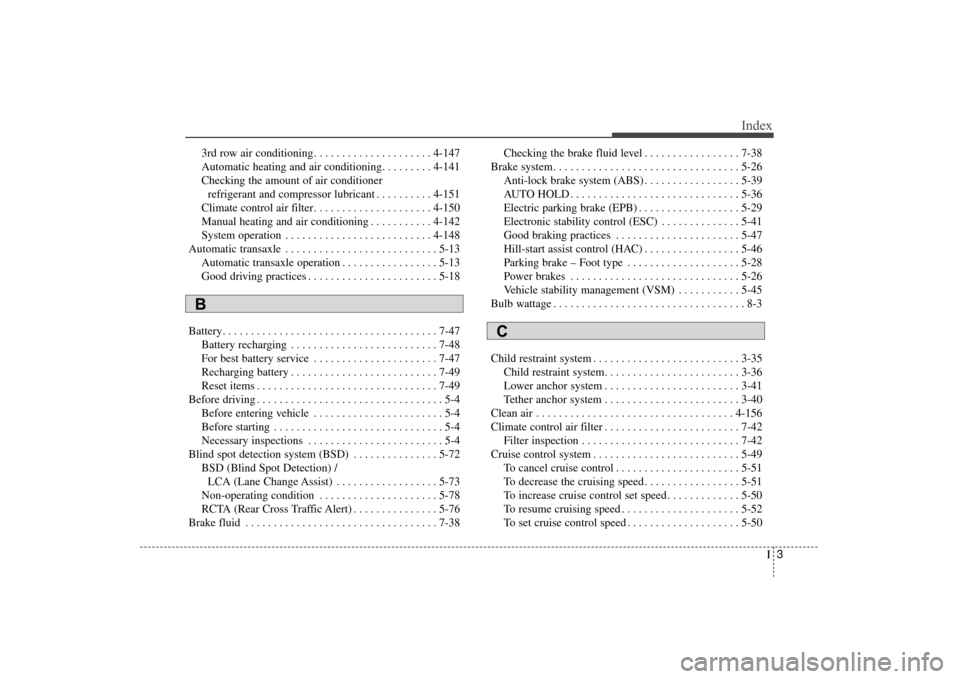
I3
Index
3rd row air conditioning. . . . . . . . . . . . . . . . . . . . . 4-147
Automatic heating and air conditioning. . . . . . . . . 4-141
Checking the amount of air conditionerrefrigerant and compressor lubricant . . . . . . . . . . 4-151
Climate control air filter. . . . . . . . . . . . . . . . . . . . . 4-150
Manual heating and air conditioning . . . . . . . . . . . 4-142
System operation . . . . . . . . . . . . . . . . . . . . . . . . . . 4-148
Automatic transaxle . . . . . . . . . . . . . . . . . . . . . . . . . . . 5-13 Automatic transaxle operation . . . . . . . . . . . . . . . . . 5-13
Good driving practices . . . . . . . . . . . . . . . . . . . . . . . 5-18
Battery. . . . . . . . . . . . . . . . . . . . . . . . . . . . . . . . . . . . \
. . 7-47 Battery recharging . . . . . . . . . . . . . . . . . . . . . . . . . . 7-48
For best battery service . . . . . . . . . . . . . . . . . . . . . . 7-47
Recharging battery . . . . . . . . . . . . . . . . . . . . . . . . . . 7-49
Reset items . . . . . . . . . . . . . . . . . . . . . . . . . . . . . . . . 7-49
Before driving . . . . . . . . . . . . . . . . . . . . . . . . . . . . . . . . . 5-4 Before entering vehicle . . . . . . . . . . . . . . . . . . . . . . . 5-4
Before starting . . . . . . . . . . . . . . . . . . . . . . . . . . . . . . 5-4
Necessary inspections . . . . . . . . . . . . . . . . . . . . . . . . 5-4
Blind spot detection system (BSD) . . . . . . . . . . . . . . . 5-72 BSD (Blind Spot Detection) /LCA (Lane Change Assist) . . . . . . . . . . . . . . . . . . 5-73
Non-operating condition . . . . . . . . . . . . . . . . . . . . . 5-78
RCTA (Rear Cross Traffic Alert) . . . . . . . . . . . . . . . 5-76
Brake fluid . . . . . . . . . . . . . . . . . . . . . . . . . . . . . . . . . . 7-38\
Checking the brake fluid level . . . . . . . . . . . . . . . . . 7-38
Brake system. . . . . . . . . . . . . . . . . . . . . . . . . . . . . . . . . 5-26 Anti-lock brake system (ABS) . . . . . . . . . . . . . . . . . 5-39
AUTO HOLD . . . . . . . . . . . . . . . . . . . . . . . . . . . . . . 5-36
Electric parking brake (EPB) . . . . . . . . . . . . . . . . . . 5-29
Electronic stability control (ESC) . . . . . . . . . . . . . . 5-41
Good braking practices . . . . . . . . . . . . . . . . . . . . . . 5-47
Hill-start assist control (HAC) . . . . . . . . . . . . . . . . . 5-46
Parking brake – Foot type . . . . . . . . . . . . . . . . . . . . 5-28
Power brakes . . . . . . . . . . . . . . . . . . . . . . . . . . . . . . 5-26
Vehicle stability management (VSM) . . . . . . . . . . . 5-45
Bulb wattage . . . . . . . . . . . . . . . . . . . . . . . . . . . . . . . . . . 8-3
Child restraint system . . . . . . . . . . . . . . . . . . . . . . . . . . 3-35 Child restraint system. . . . . . . . . . . . . . . . . . . . . . . . 3-36
Lower anchor system . . . . . . . . . . . . . . . . . . . . . . . . 3-41
Tether anchor system . . . . . . . . . . . . . . . . . . . . . . . . 3-40
Clean air . . . . . . . . . . . . . . . . . . . . . . . . . . . . . . . . . . . 4-\
156
Climate control air filter . . . . . . . . . . . . . . . . . . . . . . . . 7-42 Filter inspection . . . . . . . . . . . . . . . . . . . . . . . . . . . . 7-42
Cruise control system . . . . . . . . . . . . . . . . . . . . . . . . . . 5-49 To cancel cruise control . . . . . . . . . . . . . . . . . . . . . . 5-51
To decrease the cruising speed . . . . . . . . . . . . . . . . . 5-51
To increase cruise control set speed . . . . . . . . . . . . . 5-50
To resume cruising speed . . . . . . . . . . . . . . . . . . . . . 5-52
To set cruise control speed . . . . . . . . . . . . . . . . . . . . 5-50
B
C
UM CAN (ENG) INDEX.qxp 12/1/2014 11:55 AM Page 3
Page 564 of 565
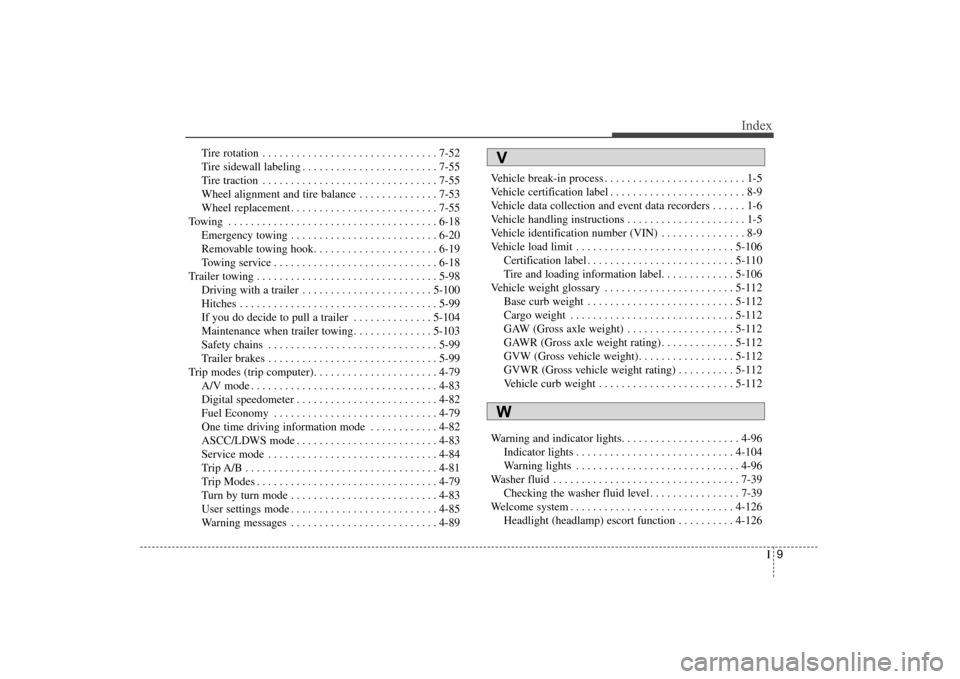
I9
Index
Tire rotation . . . . . . . . . . . . . . . . . . . . . . . . . . . . . . . 7-52
Tire sidewall labeling . . . . . . . . . . . . . . . . . . . . . . . . 7-55
Tire traction . . . . . . . . . . . . . . . . . . . . . . . . . . . . . . . 7-55
Wheel alignment and tire balance . . . . . . . . . . . . . . 7-53
Wheel replacement . . . . . . . . . . . . . . . . . . . . . . . . . . 7-55
Towing . . . . . . . . . . . . . . . . . . . . . . . . . . . . . . . . . . . . \
. 6-18 Emergency towing . . . . . . . . . . . . . . . . . . . . . . . . . . 6-20
Removable towing hook. . . . . . . . . . . . . . . . . . . . . . 6-19
Towing service . . . . . . . . . . . . . . . . . . . . . . . . . . . . . 6-18
Trailer towing . . . . . . . . . . . . . . . . . . . . . . . . . . . . . . . . 5-98 Driving with a trailer . . . . . . . . . . . . . . . . . . . . . . . 5-100
Hitches . . . . . . . . . . . . . . . . . . . . . . . . . . . . . . . . . . . 5-\
99
If you do decide to pull a trailer . . . . . . . . . . . . . . 5-104
Maintenance when trailer towing. . . . . . . . . . . . . . 5-103
Safety chains . . . . . . . . . . . . . . . . . . . . . . . . . . . . . . 5-99
Trailer brakes . . . . . . . . . . . . . . . . . . . . . . . . . . . . . . 5-99
Trip modes (trip computer). . . . . . . . . . . . . . . . . . . . . . 4-79 A/V mode . . . . . . . . . . . . . . . . . . . . . . . . . . . . . . . . . 4-83
Digital speedometer . . . . . . . . . . . . . . . . . . . . . . . . . 4-82
Fuel Economy . . . . . . . . . . . . . . . . . . . . . . . . . . . . . 4-79
One time driving information mode . . . . . . . . . . . . 4-82
ASCC/LDWS mode . . . . . . . . . . . . . . . . . . . . . . . . . 4-83
Service mode . . . . . . . . . . . . . . . . . . . . . . . . . . . . . . 4-84
Trip A/B . . . . . . . . . . . . . . . . . . . . . . . . . . . . . . . . . . 4-81\
Trip Modes . . . . . . . . . . . . . . . . . . . . . . . . . . . . . . . . 4-79
Turn by turn mode . . . . . . . . . . . . . . . . . . . . . . . . . . 4-83
User settings mode . . . . . . . . . . . . . . . . . . . . . . . . . . 4-85
Warning messages . . . . . . . . . . . . . . . . . . . . . . . . . . 4-89 Vehicle break-in process . . . . . . . . . . . . . . . . . . . . . . . . . 1-5
Vehicle certification label . . . . . . . . . . . . . . . . . . . . . . . . 8-9
Vehicle data collection and event data recorders . . . . . . 1-6
Vehicle handling instructions . . . . . . . . . . . . . . . . . . . . . 1-5
Vehicle identification number (VIN) . . . . . . . . . . . . . . . 8-9
Vehicle load limit . . . . . . . . . . . . . . . . . . . . . . . . . . . . 5-106
Certification label . . . . . . . . . . . . . . . . . . . . . . . . . . 5-110
Tire and loading information label. . . . . . . . . . . . . 5-106
Vehicle weight glossary . . . . . . . . . . . . . . . . . . . . . . . 5-112 Base curb weight . . . . . . . . . . . . . . . . . . . . . . . . . . 5-112
Cargo weight . . . . . . . . . . . . . . . . . . . . . . . . . . . . . 5-112
GAW (Gross axle weight) . . . . . . . . . . . . . . . . . . . 5-112
GAWR (Gross axle weight rating) . . . . . . . . . . . . . 5-112
GVW (Gross vehicle weight). . . . . . . . . . . . . . . . . 5-112
GVWR (Gross vehicle weight rating) . . . . . . . . . . 5-112
Vehicle curb weight . . . . . . . . . . . . . . . . . . . . . . . . 5-112
Warning and indicator lights. . . . . . . . . . . . . . . . . . . . . 4-96 Indicator lights . . . . . . . . . . . . . . . . . . . . . . . . . . . . 4-104
Warning lights . . . . . . . . . . . . . . . . . . . . . . . . . . . . . 4-96
Washer fluid . . . . . . . . . . . . . . . . . . . . . . . . . . . . . . . . . 7-39 Checking the washer fluid level . . . . . . . . . . . . . . . . 7-39
Welcome system . . . . . . . . . . . . . . . . . . . . . . . . . . . . . 4-126 Headlight (headlamp) escort function . . . . . . . . . . 4-126V
W
UM CAN (ENG) INDEX.qxp 12/1/2014 11:55 AM Page 9